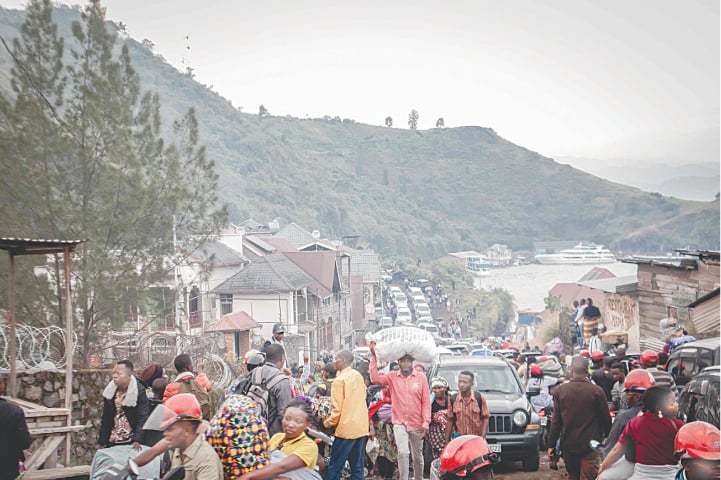GOMA: Tens of thousands of people fled the eastern DR Congo city of Goma on Thursday, choking highways, after the local governor warned in a dawn broadcast of a possible new eruption of the volcano Mount Nyiragongo.
The volcano’s monitors also pointed to a potentially catastrophic scenario — a “limnic eruption” that could smother the area with suffocating carbon dioxide.
The government said a team of experts was at the summit of the volcano carrying out a risk assessment.
The city, located on the shore of Lake Kivu, has been on edge since Africa’s most active volcano erupted on Saturday, leaving 32 people dead.
“Right now we can’t rule out an eruption on land or under the lake, which could happen very soon and without warning,” said General Constant Ndima, the military governor of North Kivu province.
He said an evacuation of part of the city of more than 600,000 — among some two million in the greater urban area — had been ordered, and urged residents to leave calmly. Ndima, warning that “the situation can change rapidly, and is being constantly monitored,” said authorities had arranged transport towards Sake, around 20 kilometres west of Goma.
But Agnes Kahindo, trying to make her way to Sake, said: “We don’t see these means to leave Goma. There are too many traffic jams, and the price of motorbike taxis has shot up.” Traffic was backed up for several kilometres on the road headed west, a reporter said.
One Goma resident said: “It’s fear, it’s panic, everyone is fleeing!” Tens of thousands fled Goma last weekend after Nyiragongo erupted on Saturday night, although many returned. But strong aftershocks have continued to rattle the city, causing some buildings to collapse and leaving residents fearful.
The volcano spewed out two rivers of molten rock during the eruption, one of which came to halt on the edge of Goma after obliterating villages in its wake.
The UN humanitarian agency OCHA said more than 4,500 homes were destroyed, affecting some 20,000 people.
Local volcanologists have recorded hundreds of aftershocks since Nyiragongo, which sits just a dozen kilometres (eight miles) from Goma, roared back to life.
Ndima said the latest data “indicates the presence of magma under the urban area of Goma, with an extension under Lake Kivu.” Interaction between magma and the lake posed additional risks, including “the emission of potentially dangerous gases at the surface,” he said. Volcanologists have warned of a possible worst-case scenario in which an eruption occurs beneath the floor of Lake Kivu.
This could cause carbon dioxide dissolved in the lake’s depths to rise to the surface, releasing invisible clouds of suffocating gas.
In a “limnic eruption” of this kind in 1986, more than 1,700 people and thousands of cattle died in Lake Nyos, in Cameroon. Government spokesman Patrick Muyaya said a team of experts sent early Thursday to the summit of the volcano were evaluating the various risks.
He told a press conference that another disaster scenario was that of an “explosion of a pocket of (methane) gas” lying beneath the lake, if this were to come into contact with magma.
There was also the toxic risk from dust and ash disgorged into the air by the volcano, he said. Its last major eruption, in 2002, claimed around 100 lives. The deadliest eruption on record killed more than 600 people in 1977.
